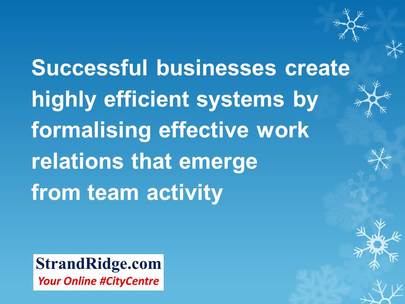Driving sustained performance
With just a few weeks of basic training the military can turn unskilled individuals into war heroes. Soldiers don’t just learn the skills of how to blow up bridges they also know how to build them.
Business consults and trainers apply similar methods such as simulations and role play studies that re-enforce new knowledge and hone skills through practical exercises.
Competitive leaders are good at organising highly skilled and deeply knowledgeable individuals into a team to implement their vision and values in a practical manner to achieve goals.
Successful businesses create highly efficient systems by formalising effective work relations that emerge from team activity.
When Raymond retired from the military he established and grew rapidly a transport company with a fleet of trucks that could deliver goods across the country. When I met him he was in the process of computerizing the monitoring of his trucks in real-time so that he could more effectively deploy his trucks to ensure maximum utilization of his resources. This required introducing to Raymond a total logistic management consultant to work with the computer software engineer to create the system. His goal was to improve productivity and reduce turnaround time for his trucks so they could make more deliveries. Raymond believed this was necessary to maintain his profit margin while keeping out competitors from across the border.
It is necessary to build a solid foundation for sustained success. The following are the 7 pillars that form the foundation for sustained business success:
1. Leadership
Effective organizations have strong leaders with vision and clear goals. Strong leadership is built on the foundation of positive values that inspire team members to give their very best. .
2. Management
To achieve organisational goals it is necessary to have managers with a mission to achieve goals in a way that expresses the vision and values of the leadership
3. Market
It is necessary to identify and cultivate the market for what the business offers. This requires investing in identifying the niche market that is willing to buy.
4. Head Office
This is the command centre from which the leader gathers all information for analysis in order to stay in control of the business even as the leader delegates duties to others.
5. Capital
Human and financial capital are necessary to run the business. Hire the best and utilize financial capital to get the best return on investment.
6. The Team
The talent pool within the business needs to be a group of specialist who can be motivated to work together to achieve common goals.
7. The Consultant
This is the person who acts as the leaders trusted adviser and who gives objective advice. The consultant gets leaders to face the hard facts of when to invest more, when to shift strategy and when it may be necessary to exit from a venture.
Siddha Param
International Business Consultant
Reboot your business plan for sustained high growth
Click For Link To:
BUSINESS SERVICES
CENTRE FOR EXCELLENCE
BUSINESS EXCHANGE MALL CONNECTIONS
Do share this article on social media and with those interested

 RSS Feed
RSS Feed
